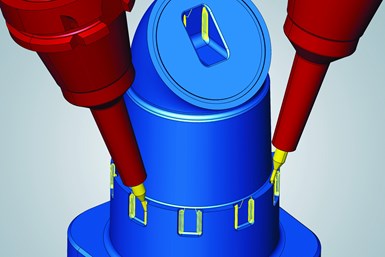Open Mind CAD/CAM Software Increases Programming Efficiency
The HyperMill 2024 CAD/CAM software enables increased NC programming efficiency in applications ranging from 2.5D machining to five-axis milling.
Share









ECi Software Solutions, Inc.
Featured Content
View More


Takumi USA
Featured Content
View MoreOpen Mind Technologies has introduced its latest HyperMill 2024 CAD/CAM software suite, which includes enhancements to its core toolpath capabilities as well as new functionality for increased NC programming efficiency in applications ranging from 2.5D machining to five-axis milling.
An optimized deep-hole drilling CAM strategy offers improved machining reliability with an interface that clearly defines process-relevant parameters. New capabilities enable coolant and dwell time stages to be identified, enable a chipbreaker to be integrated into a drilling process and more. A new single-tip gun-drill tool simulation provides precise collision checking and a detailed visualization of the stock removal.
HyperMill 2024 includes a new algorithm for three-axis and five-axis, Rest Machining, which provides automatic, complete detection of all rest material areas, in addition to optimized toolpath calculations for faster, more reliable machining. Tool paths are now optimally divided to ensure more efficient machining, and the detection of intersection areas where paths meet has been optimized for collision avoidance.
An additional toolpath improvement is an enhanced path layout for the 3D Plane Machining cycle. The new strategy has a smoother path and fewer pickups. While the toolpath length (distance) may be longer in some cases, the machining time has reportedly been reduced.
A new generation of programming assistance and analysis, CAM Plan, is introduced in HyperMill 2024 to simplify various programming tasks and identify possible sources of error. Pre-defined workflow steps safely guide users through the preparation and programming process, while the geometries and features required are automatically created. Also, potential errors are flagged for removal, such as double surfaces or gaps between model patches.
Once the data is organized, the CAM workflow can be processed with more intelligence and higher efficiency. HyperMill CAM Plan enables component topology analysis to produce a precise tool path that has command locations aligned with key geometric features and with optimized point distribution for milling. The result is improved surface finishes, easier processing by NC controllers and reduced machining times.
For easy generation of three-axis and five-axis NC programs with axis change and an optimized use of the workspace, the NC Optimizer feature in the HyperMill Virtual Machining strategy now offers the option to transform X- and Y-axis movements into a single movement with the rotation axis in the table. By swapping axes, an XY movement is transformed into a simultaneous CX movement which eliminates rewind movements during machining. According to the company, this is especially beneficial for machines that have a limited linear-axis range.
The reading back of measuring points when using HyperMill Virtual Machining is a new feature that enables graphical representation of measured points on the part model, rather than comparing a list of measurement results. Users can also quickly identify measuring points that are out of tolerance on a 3D part model and compare trends over sequential measurements. As a result, it is much easier to analyze and compensate for inaccuracies and tool wear after milling.
Related Content
-
Continuous Improvement and New Functionality Are the Name of the Game
Mastercam 2025 incorporates big advancements and small — all based on customer feedback and the company’s commitment to keeping its signature product best in class.
-
How to Mitigate Chatter to Boost Machining Rates
There are usually better solutions to chatter than just reducing the feed rate. Through vibration analysis, the chatter problem can be solved, enabling much higher metal removal rates, better quality and longer tool life.
-
The Power of Practical Demonstrations and Projects
Practical work has served Bridgerland Technical College both in preparing its current students for manufacturing jobs and in appealing to new generations of potential machinists.




















.png;maxWidth=150)












.jpg;maxWidth=300;quality=90)

.jpg;maxWidth=300;quality=90)
